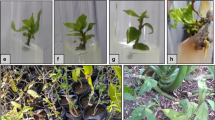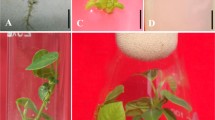Abstract
The chinese tree Camptotheca acuminata produces the anti-cancer and anti-retroviral drug camptothecin. Methods were developed for the clonal propagation of this important medicinal plant through shoot bud culture. Shoot buds were excised from 25 to 30 day old seedlings, presoaked for 48 h in three different liquid media containing either BA (2.22–17.4 μM), kinetin (2.32–18.58 μM), or thidiazuron (0.1–10 μM) and were subsequently cultured on semi-solid medium of the same composition. Multiple shoots only developed from the 6-benzyladenine presoaked explants with the maximum number of shoots initiated from buds presoaked in and grown on B5 medium containing 17.4 μM 6-benzyladenine. Individual shoots were removed from clusters and rooted on B5 supplemented with indole-3-butyric acid (4.9–19.6 μM). The lowest concentration of indole-3-butyric acid (4.9 μM) gave the highest percentage of rooting (82%) and the shortest root initiation period (18 d). Over 90% of the in vitro rooted plantlets survived transfer to soil.
Similar content being viewed by others

Abbreviations
- BA:
-
6-benzyladenine
- B5:
-
Gamborg's B5 medium (Gamborg et al., 1968)
- CPT:
-
camptothecin
- 2,4-d :
-
2,4-dichlorophenoxyacetic acid
- IBA:
-
indole-3-butyric acid
- kinetin:
-
6-furfurylaminopurine
- LS:
-
Linsmaier & Skoog medium (Linsmaier & Skoog, 1965)
- MS:
-
Murashige & Skoog (Murashige & Skoog, 1962)
- NAA:
-
I-naphthaleneacetic acid
- PGR:
-
plant growth regulator
- TDZ:
-
thidiazuron
- WPM:
-
woody plant medium (Lloyd & McCown, 1981)
References
Cragg GM, Schepartz SA, Suffness M & Grever MR (1993) The taxol supply crisis. New NCI policies for handling the largescale production of novel natural product anticancer and anti-HIV agents. J. Natural Products 56:1657–1668
Gamborg OL, Miller RA & Ojima K (1968) Nutrient requirements of suspension cultures of soybean root cells. Exp. Cell. Res. 50:151–158
George L, Bapat VA & Rao PS (1987) In vitro multiplication of sesame (Sesamum indicum) through tissue culture. Annals of Bot. 60:17–21
Huetteman CA & Preece JE (1993) Thidiazuron: a potent cytokinin for woody plant tissue culture. Plant Cell Tiss. Org. Cult. 33:105–119
Jain AK & Datta RK (1992) Shoot organogenesis and plant regeneration in mulberry (Morus bombycis Koidz): Factors influencing morphogenetic potential in callus cultures. Plant Cell Tiss. Org. Cult. 29:43–50
Kjeldsen E, Bendixen C, Thomsen B, Christiansen K, Bonven BJ, Nielsen OF & Westergaard O (1990) In: Ross W & Potmesil M (eds) DNA Topoisomerase and Cancer. Oxford University Press, Oxford, UK
Kjeldsen E, Svejstrup JQ, Gromova II, Alsner J & Westergaard O (1992) Camptothecin inhibits both the cleavage and religation reactions of eukaryotic DNA topoisomerase I. J. Mol. Biol. 228:1025–1030
Li CJ, Zhang LJ, Dezube BJ, Crumpacker CS & Pardes AB (1993) Three inhibitors of type I human immunodeficiency virus long terminal repeat-directed gene expression and virus replication. Proc. Natl. Acad. Sci. USA 90:1839–1842
Li CJ, Wang C & Pardee AB (1994) Camptothecin inhibits Tatmediated transactivation of type 1 human immunodeficiency virus. J. Biol. Chem. 269:7051–7054
Linsmaier EM & Skoog F (1965) Organic growth factor requirements of tobacco tissue cultures. Physiol. Plant. 18:100–127
Lloyd G & McCown B (1981) Commercially-feasible micropropagation of mountain laurel, Kalmia latifolia, by use of shoot-tip culture. Combined proceedings-International Plant Propagator's Society 30:421–427
López-Meyer M, Nessler CL & McKnight TD (1994) Sites of accumulation of the antitumor alkaloid camptothecin in Camptotheca accuminata. Planta Med. 60:558–560
Murashige T & Skoog F (1962) A revised medium for rapid growth and bioassay with tobacco tissue culture. Physiol. Plant. 15:473–497
Perdue RE, Smith RL, Wall ME, Hartwell JW & Abbot BJ (1970) Camptotheca acuminata Decaisne (Nyssaceae) source of camptothecin, an antileukemic alkaloid. USDA Tech. Bull. No. 1415
Priel E, Showalter SD & Blair DG (1991a) Inhibition of human immunodeficiency virus (HIV-1) replication by non cytotoxic doses of camptothecin, a topoisomerase I inhibitor. AIDS Res. Hum. Retroviruses 7:65–72
Priel E, Showalter SD, Roberts M, Oroszlan S & Blair DG (1991b) The topoisomerase I inhibitor, camptothecin, inhibits equine infectious anemia virus replication in chronically infected CF2Th cells. J. Virol. 65:4137–4141
Priel E, Aflalo E, Chechelnitsky G, Benharroch D, Aboud M & Segal S (1993) Inhibition of retrovirus-induced disease in mice by camptothecin. J. Virol. 67:3624–3629
Wall ME, Wani MC, Cook CE & Palmer KH (1966) Plant antitumor agents I. The isolation and structure of camptothecin—a novel alkaloidal leukemia and tumor inhibitor from Camptotheca acuminata. J. Amer. Chem. Soc. 88:3888–3890
Author information
Authors and Affiliations
Rights and permissions
About this article
Cite this article
Jain, A.K., Nessler, C.L. Clonal propagation of Camptotheca acuminata through shoot bud culture. Plant Cell Tiss Organ Cult 44, 229–233 (1996). https://doi.org/10.1007/BF00048528
Received:
Accepted:
Issue Date:
DOI: https://doi.org/10.1007/BF00048528



